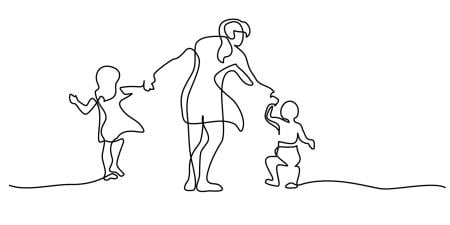Tong R. Long-term care for the elderly worldwide: whose responsibility is it?
Int J Feminist Approaches Bioethics. 2009;2(2):5-30.
Looking at care work in the context of the global migration of workers from low-income regions to higher-income regions offers an additional dimension to Rosemarie Tong’s ethical analysis of who is and ought to be responsible for the long-term care of older members of affluent societies. Tong points out that caregiving, including the care of the elderly at home, is a responsibility that often falls to women, as hands-on givers and organizers of care. In the globalized world of work nearly one in two economic migrants is a woman and it is common for “family” caregiving work in developed nations to be performed by migrant women employed by families. In this commentary, we consider the ethical implications of relying on economic migrants, who are often mothers themselves, to care for the mothers (and fathers, and children) of others.
According to the International Organization for Migration (IOM), a Geneva-based intergovernmental organization, there is no single definition of “migrant” [1]. Most definitions of migrant workers refer to low-income, low-skilled workers, who are seasonally employed (as in agriculture) or guest workers in countries other than those in which they were born, or who live year-round as immigrants, without authorization, in the countries in which they work (undocumented or unauthorized migrants). Economic migrants leave home to find work, or better-paying work, and their remittances support families and communities back home. Remittances from Filipino/a migrant workers, for example, totaled $17.3 billion in 2009, constituting more than 10 percent of the gross domestic product of the Philippines [2].
The United Nations estimates that, in 2008, 105 million women were migrant workers, constituting 49 percent of the total estimated migrant population worldwide [3]. Human Rights Watch, a major nongovernmental organization (NGO), estimates that the “vast majority” of the world’s 50 million to 100 million domestic workers, a category that includes caregivers for the elderly, are women, and that “migrants constitute an increasingly large proportion of domestic workers” [4]. Female domestic workers include “domestic helpers” or “maids” from the Philippines, Indonesia, or other emerging nations in Asia who find work in households in Singapore, Hong Kong, or the Persian Gulf through recruitment agencies and usually live in their employers’ homes. They include legal and undocumented immigrant women from the Caribbean, Latin America, Africa, or Asia who care for the elderly and for children in the United States. Human Rights Watch estimates that up to 30 percent of migrant domestic workers are children, usually girls [5].
In recent years, human rights NGOs, migration-focused NGOs, the World Bank, the World Health Organization, and the United Nations have drawn attention to the situation of migrant women workers as a vulnerable population [6]. Because domestic workers’ places of employment are their employers’ homes, and because they may have no colleagues and few protections in this workplace, their working conditions can be isolating as well as physically demanding. Some migrants who do domestic work endure virtual indentured servitude when they find themselves unable to leave a work situation that is abusive or exploitative [7]. They are also vulnerable to scams. In the U.S., migrant workers constitute the majority of the $4 billion annual market for telephone calling cards, and the Federal Trade Commission (FTC) has investigated scams that prey on this group of consumers [8]. Female domestic workers, like other economic migrants, can become stuck on the social and economic margins of the places where they live, invisible to the other members of the societies they contribute to through their labor, and not present in the societies back home that they help to support through remittances. And yet these women may have, if not “good” jobs, at least jobs that, because of the persistent wage gap between poorer and wealthier nations, allow them to earn more money than they could have if they remained at home.
So, should we accept that, in a globalized world, responsibility for the long-term care of the elderly in wealthier nations will depend on migrant workers from poorer nations? To put it another way, is a migrant worker an imperfect solution to the problem Tong describes of “ingrained notions about who should care (women) and who should work (men)”? If women in more-developed nations can subcontract their family caregiving responsibilities to women from less-developed nations, thereby allowing the wealthier women to continue to work or pursue other goals and the poorer women to send money home to their children and elders, is this a just arrangement—for each of these groups of women, for each of these societies—or not?
These questions are important for physicians and other health care professionals to consider, because understanding who provides care at home (or accompanies elderly people to medical appointments, or sits with them in the hospital) is part of everyday health care work, as when a patient is being sent home from the hospital and a “safe and effective” discharge plan must be put into place. The home care worker who is invisible to health care professionals will have little power to question or fix a care plan that is not working; her options will be reduced to trying to make the flawed plan work (with potentially bad consequences for the patient) or to quit her job. These questions are also important in health care ethics because the domestic worker is herself a person, not merely an instrument through which “care” is provided, and because her perspective on a patient’s condition and preferences may be different from the perspectives of the patient’s family members [9].
Imagine, for example, an elderly patient who is cognitively impaired as the result of a stroke or a progressive form of dementia and whose family has hired a migrant worker to care for him at home. The person with authority to make medical decisions on behalf of this patient, if the patient’s preferences are unknown, is likely to be a family member, such as a spouse or an adult child, acting as the patient’s surrogate. If the migrant worker does not agree with the care plan that reflects the surrogate’s decisions, what should the worker do? Where can this person turn with her ethical concerns?
Possible arguments supporting the employment of migrant workers as long-term care providers for the elderly (and others) in wealthier nations include support for “flourishing” as a basic human freedom or right. Shouldn’t a woman have the freedom to pursue opportunities to support herself and her family, including opportunities for paid (or better-paid) work not available in her home country or region?
Tong describes the problem of female family members, especially daughters and daughters-in-law, being at risk of becoming trapped in unpaid caregiving roles, with serious consequences for their own professional advancement and other goals—a risk male family members do not face. This common problem is reflected in another argument that can be made in support of the employment of migrant workers as long-term care providers for the elderly: if subcontracting care work to migrant workers not only creates work opportunities for one group of women but also offers more freedom to another group of women, does this further increase this transaction’s support for human flourishing?
We should also consider whether subcontracting care work is better for the people in need of care. It seems plausible that a worker who is employed to focus on the needs of the elderly (or other) person in need of care could, if adequately trained, provide a better quality of care than female family members, who, as Tong points out, are likely to be caring for their own children, running their own households, and trying to keep their own working lives afloat.
However, there are significant arguments against relying on migrant workers as a way to “solve” the problem of too few hands for unpaid care among family members in wealthier nations, including the unfairness that women (but not men) are expected to perform care work for free.
The “capability” approach to improving the prospects of women in the developing world is articulated by scholars such as economist Amartya Sen and philosopher Martha Nussbaum [10, 11]. Capability is an ethically grounded theory that takes “development as freedom” as its hypothesis and its practical goal. It asserts that people should be free and that the freedom of women and girls merits special attention because of the historical and continuing harms of gender-based oppression. It thus promotes selecting economic development projects that enhance health, safety, and opportunities for this population.
From the perspective of capability theory, economic development strategies that promote migration by women and girls rather than opportunities at home (through scholarships, job training, or capital loans to start or expand small businesses, for example) could be viewed as less than freedom-enhancing because they have the potential to trap these women on the margins of a wealthier society without opportunities for advancement or integration. A capability approach is, arguably, more supportive of women as mothers and members of their own families than is a migration-based strategy. The capability approach focuses on developing opportunities for women (and others) in their own communities, presenting “development as freedom” and criticizing states that fail to invest in the health, education, employment, and future of their own societies.
Efforts to secure better conditions for migrant women in the societies in which they work also draw on capability theory. However, it is not difficult to see that, when the economic welfare of a family relies on mothers to migrate, to leave their children and elders to care for the children and elders of others, local development might have made it possible for these mothers to find work closer to their own families, and to have made a freer choice to stay or to go.
Furthermore, subcontracting care work from female family members to other women does not succeed in weakening the association between care work and gender: it remains women’s work, for different women. Subcontracting care work “downward,” from women with more power (acquired through money, education, or both) to women with less power, can perpetuate the notion that poorer, less educated women, or those from societies perceived as “traditional,” are better at, or do not mind, or should not have aspirations beyond, caregiving work. Political philosopher Michael Walzer describes the idea of democratic societies “run[ning] their economies with live-in servants”—that is, on the labor of people who live in the society but are not recognized as members of the society—as “practically and theoretically troubling” [12]. Recognizing that home care work in developed nations is often low-status work; that low-status work (especially physically demanding “dirty work”) is often where the migrant can hope to find employment; and that, given a choice, the migrant might prefer to do different work, puts things on a clearer ethical footing.
Mindful that the global migration of labor is a reality and that one of the major driving forces for migration by women is, and is likely to continue to be, the availability of caregiving work in wealthier nations, improving working conditions for migrant women and ensuring that elderly (and other) persons in need of care receive good care are intertwined goals. Health care professionals who are responsible for the care of elders (and others) who receive care at home can support these goals by asking whose hands provide home care, recognizing those people as members of the care team, identifying the skills needed to provide good care at home, supporting the ability of those who provide care (whether paid or unpaid) to acquire these skills, and lending their voices to efforts to improve compensation, protections, and other forms of support for all caregivers.
References
-
International Organization for Migration. Key migration terms: migrant. Accessed July 2, 2013.
-
Onishi N. Toiling far from home for Philippine dreams. New York Times. September 19, 2010: A6. http://www.nytimes.com/2010/09/19/world/asia/19phils.html?pagewanted=all. Accessed July 3, 2013.
-
The International Organization for Migration. Facts and figures: 2010. Accessed June 20, 2013.
-
Human Rights Watch. ILO: new landmark treaty to protect domestic workers. June 16, 2011. http://www.hrw.org/news/2011/06/16/ilo-new-landmark-treaty-protect-domestic-workers. Accessed July 3, 2013.
-
Becker J. Child domestic workers: “time to protect us.” Human Rights Watch. February 26, 2013. http://www.hrw.org/news/2013/02/26/child-domestic-workers-time-protect-us. Accessed July 3, 2013.
-
United Nations Entity for Gender Equality and the Empowerment of Women (UN Women). Supporting women workers towards a safer migration journey. December 18, 2012. Accessed July 3, 2013.
-
Morin R. Indentured servitude in the Persian Gulf. New York Times.April 12, 2013: SR4. http://www.nytimes.com/2013/04/14/sunday-review/indentured-servitude-in-the-persian-gulf.html?pagewanted=all. Accessed July 3, 2013.
-
FTC asks court to halt prepaid calling card scam; alleges consumers receive fewer calling minutes than advertised and pay hidden fees [news release]. Washington, DC: Federal Trade Commission; March 26, 2008. http://www.ftc.gov/opa/2008/03/cta.shtm. Accessed July 1, 2013.
- Collopy B, Dubler N, Zuckerman C. The ethics of home care: autonomy and accommodation. Hastings Cent Rep. 1990;20(2):S1-S16.
-
Sen A. Development as Freedom. New York: Random House; 1999.
-
Nussbaum MC. Women and Human Development: The Capabilities Approach. Cambridge: Cambridge University Press; 2000.
-
Walzer M. Spheres of Justice: A Defense of Pluralism and Equality.New York: Basic Books; 1984: 55.



